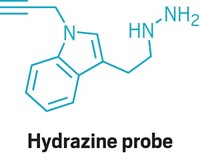Advertisement
Grab your lab coat. Let's get started
Welcome!
Welcome!
Create an account below to get 6 C&EN articles per month, receive newsletters and more - all free.
It seems this is your first time logging in online. Please enter the following information to continue.
As an ACS member you automatically get access to this site. All we need is few more details to create your reading experience.
Not you? Sign in with a different account.
Not you? Sign in with a different account.
ERROR 1
ERROR 1
ERROR 2
ERROR 2
ERROR 2
ERROR 2
ERROR 2
Password and Confirm password must match.
If you have an ACS member number, please enter it here so we can link this account to your membership. (optional)
ERROR 2
ACS values your privacy. By submitting your information, you are gaining access to C&EN and subscribing to our weekly newsletter. We use the information you provide to make your reading experience better, and we will never sell your data to third party members.
Biological Chemistry
Phage Display Finds Bioorthogonal Chemistry
Technique speeds palladium-mediated cross-coupling
by Carmen Drahl
July 28, 2014
| A version of this story appeared in
Volume 92, Issue 30
To track biochemical goings-on in living things, researchers frequently turn to bioorthogonal chemistry. These reactions attach probes to compounds of interest without disturbing natural reactions. Because biology is diverse, discovering more such reactions is a priority. Now, chemists have adapted phage display to identify promising candidates (ACS Chem. Biol. 2014, DOI: 10.1021/cb500443x). Qing Lin sought to streamline the discovery process by optimizing bioorthogonal chemistry directly in a biological system. He reasoned that a reaction conducted in a peptide microenvironment might be both rapid and specific, desirable traits for bioorthogonal chemistry, if the peptide makes just the right noncovalent interactions with the reaction partners. He and his colleagues at the University at Buffalo, SUNY, tried phage display, a method that uses a natural-selection-like process to choose a peptide from a large library. The team identified a specific peptide sequence that speeds up a palladium-mediated bioorthogonal cross-coupling (shown above). Neal Devaraj, who develops bioorthogonal chemistry at the University of California, San Diego, calls the phage display strategy clever and thought provoking. He’d like to see future studies optimize reactions that don’t require a metal catalyst.






Join the conversation
Contact the reporter
Submit a Letter to the Editor for publication
Engage with us on Twitter